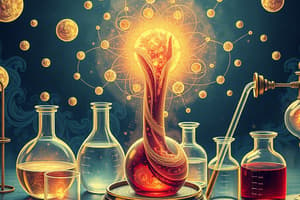Podcast
Questions and Answers
Why are Disallowed Molecular Orbitals (DMOs) considered NEETs in chemistry?
Why are Disallowed Molecular Orbitals (DMOs) considered NEETs in chemistry?
- They represent imaginary crossing points between energy levels of different electronic states. (correct)
- They are highly stable molecules that violate conservation laws.
- They follow thermodynamic feasibility and stability rules.
- They are commonly observed in nature due to their unique molecular structure.
Why do chemists never observe compounds with Disallowed Molecular Orbitals?
Why do chemists never observe compounds with Disallowed Molecular Orbitals?
- DMOs follow conservation laws and thermodynamic feasibility.
- DMOs are unstable as they violate basic stability rules in chemistry. (correct)
- DMOs are stable compounds that occur frequently in chemical reactions.
- DMOs have a unique molecular structure that prevents their observation.
What is the main reason certain orbital combinations lead to the formation of Disallowed Molecular Orbitals (DMOs)?
What is the main reason certain orbital combinations lead to the formation of Disallowed Molecular Orbitals (DMOs)?
- They represent energetically unfavorable imaginary crossing points between energy levels. (correct)
- They are commonly observed in chemical reactions due to their stability.
- They violate thermodynamic feasibility, leading to their instability.
- They are highly stable and follow conservation laws.
How do Disallowed Molecular Orbitals (DMOs) violate the principles of chemistry?
How do Disallowed Molecular Orbitals (DMOs) violate the principles of chemistry?
What makes Disallowed Molecular Orbitals (DMOs) different from stable molecules in chemical reactions?
What makes Disallowed Molecular Orbitals (DMOs) different from stable molecules in chemical reactions?
What distinguishes 'forbidden reactions' from other chemical reactions?
What distinguishes 'forbidden reactions' from other chemical reactions?
In chemistry, what is a key characteristic of equilibrium systems that exhibit 'unattainable equilibrium'?
In chemistry, what is a key characteristic of equilibrium systems that exhibit 'unattainable equilibrium'?
What is an example of an 'attainable equilibrium' as described in the text?
What is an example of an 'attainable equilibrium' as described in the text?
How are 'forbidden reactions' related to NEET concepts in chemistry?
How are 'forbidden reactions' related to NEET concepts in chemistry?
What is the outcome when equilibrium systems violate Le Chatelier's principle?
What is the outcome when equilibrium systems violate Le Chatelier's principle?
Flashcards are hidden until you start studying
Study Notes
NEET: Non-Existent Entities in Everyday Chemistry
The acronym "NEET," which stands for _Non_Engaged in Education, Employment, or Training, is often associated with young individuals who find themselves outside of these traditional paths after finishing secondary education. However, in this context, we'll explore how the term relates specifically to non-existent entities within everyday chemical reactions – compounds that can never form due to their inherent structures.
In chemistry, NEETs refer to molecules and species that don't exist because they violate basic principles such as conservation laws, stability rules, or thermodynamic feasibility. Let's dive into three types of examples illustrating why some entities remain non-existent despite seemingly plausible initial configurations based solely on molecular structure.
1. Disallowed Molecular Orbitals (DMO)
Molecular orbitals describe the distribution of electrons around atomic nuclei. In certain instances, electronic configuration calculations reveal that certain orbital combinations cannot form, leading to unstable molecules known as disallowed molecular orbitals (DMO). DMOs are NEETs in the sense that they represent imaginary crossing points between energy levels of two different electronically excited states, making them energetically unfavorable. As a result, chemists will never observe compounds exhibiting these hypothetical arrangements.
2. Forbidden Reactions
Some chemical reactions are so unlikely that it seems extraordinary for them to occur; however, there still exists an infinitesimally small probability of these events happening under specific conditions, such as extreme temperatures or pressures. But other reactions are literally impossible by nature – they break fundamental physical laws that govern matter and energy interactions. These "forbidden reactions" turn out to be NEETs because they involve processes like creating a perpetual motion machine or converting one element directly into another without passing through intermediate steps.
3. Unattainable Equilibria
Many equilibrium systems in chemistry feature constant concentrations of reactants and products that coexist together until disturbed. Some equilibria may appear to stabilize at strange positions where simple stoichiometry does not hold true. Despite our best efforts to force these systems closer to the idealized state using varying temperature and pressure factors, reaching absolute equilibrium becomes elusive if the reaction violates Le Chatelier's principle. Under these circumstances, the system remains trapped inside its current limbo–the state of unattainable equilibrium. This analogy highlights yet another instance in which NEET concepts apply within the realm of chemistry.
As you navigate your own journey through academic or real-world applications involving chemistry, remember that sometimes theory presents the most intriguing questions rather than providing straightforward answers. Stay curious… even when exploring those things that simply do not exist!
Studying That Suits You
Use AI to generate personalized quizzes and flashcards to suit your learning preferences.




